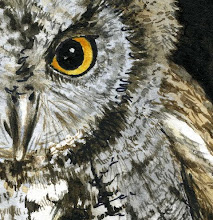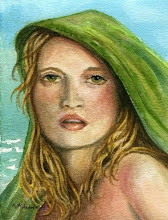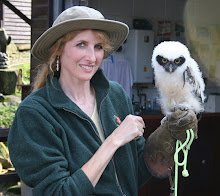Today as the sun shone and the temperatures climbed to a balmy 30 or so degrees, I felt a very strong urge to just grab my field kit and go for a hike with Ginger. I notice whenever I go out field sketching or work on a painting in the studio, it's like having a visit to the therapist! I feel like I've just had some kind of adjustment, and all is right in my world! Troubles melt away as I stop to catch my breath and listen to the wind gusting through the trees. Today was no different. (click on any picture to see enlarged view)
 First small sketch done with a micron 05 permanent marker, it's along the path that's called "Long Lane" on my farm. To warm up and to see if drawing with my fingerless mittens would feel comfortable, I did the top of a small oak tree, then turned and looked down the lane where Ginger was disappearing down, and did a quickly scrawled sketch. It's ok that it's not beautiful and meticulously drawn, I can remember the scene in my mind just be looking at it. Sometimes the field sketch can have more movement and show more excitement than a carefully executed studio drawing. I also find that being able to work loosely in the field keeps my studio painting fresh and lively looking.
First small sketch done with a micron 05 permanent marker, it's along the path that's called "Long Lane" on my farm. To warm up and to see if drawing with my fingerless mittens would feel comfortable, I did the top of a small oak tree, then turned and looked down the lane where Ginger was disappearing down, and did a quickly scrawled sketch. It's ok that it's not beautiful and meticulously drawn, I can remember the scene in my mind just be looking at it. Sometimes the field sketch can have more movement and show more excitement than a carefully executed studio drawing. I also find that being able to work loosely in the field keeps my studio painting fresh and lively looking. Just me in my dad's old wool hunting coat that I treasure, using the fingerless mitten ok. I picked up this pair in England at a regular clothes store at the mall, I made sure they had wool in them, and I like the dark brown color (to hide the dirt of course silly!). At this point I think my fingers were cold, sometimes I worked with the top pulled back and sometimes closed. I'm using a waterbrush here and watercolors, I put my kit in a new bag to try out, an over the shoulder binder type thing, but no room for apples or water bottles. Extra things had to go in the back secret pouch on the hunting jacket, made for carrying dead birds that the hunter (dad) would shoot. It's actually a handy pouch...I slid my sketchbook in there when I would get moving on my hike.
Just me in my dad's old wool hunting coat that I treasure, using the fingerless mitten ok. I picked up this pair in England at a regular clothes store at the mall, I made sure they had wool in them, and I like the dark brown color (to hide the dirt of course silly!). At this point I think my fingers were cold, sometimes I worked with the top pulled back and sometimes closed. I'm using a waterbrush here and watercolors, I put my kit in a new bag to try out, an over the shoulder binder type thing, but no room for apples or water bottles. Extra things had to go in the back secret pouch on the hunting jacket, made for carrying dead birds that the hunter (dad) would shoot. It's actually a handy pouch...I slid my sketchbook in there when I would get moving on my hike. This is a page with a simple color study of the red bark on bushes and the little fern heads coming up through the snow. Their forms, almost silhouette because they're so dark, are wonderful to study.
This is a page with a simple color study of the red bark on bushes and the little fern heads coming up through the snow. Their forms, almost silhouette because they're so dark, are wonderful to study. The photo above shows a leaf I found in a tiny birds nest that was tucked into a tangled bush. It's small things like this that if you take time to notice the subtle beauty your enjoyment of the natural world and simple walks would be much more memorable. This leaf is a simple shape, but I love the mixture of subtle colors, there's a promise of green there that makes me think of spring, it's almost as if the green was frozen from the fresh times of summer. The pattern of the veins and cells is really something too, the wet sheen on it's surface reflecting a cool light.
The photo above shows a leaf I found in a tiny birds nest that was tucked into a tangled bush. It's small things like this that if you take time to notice the subtle beauty your enjoyment of the natural world and simple walks would be much more memorable. This leaf is a simple shape, but I love the mixture of subtle colors, there's a promise of green there that makes me think of spring, it's almost as if the green was frozen from the fresh times of summer. The pattern of the veins and cells is really something too, the wet sheen on it's surface reflecting a cool light. Then turn the same leaf over and it's a whole other leaf! This side has a network of raised veins showing, like fine meshwork netting and the contrast of the color of vein to leaf is at once noticed. The fall like colors are not showing on this side. When you pick something up, turn it over and explore everything about it; if you draw it, you will study it deeply, noting it's every interesting detail. Sometimes this is good to do once you get back home and can sit in the warmth and take time to study it.
Then turn the same leaf over and it's a whole other leaf! This side has a network of raised veins showing, like fine meshwork netting and the contrast of the color of vein to leaf is at once noticed. The fall like colors are not showing on this side. When you pick something up, turn it over and explore everything about it; if you draw it, you will study it deeply, noting it's every interesting detail. Sometimes this is good to do once you get back home and can sit in the warmth and take time to study it. Here's another nest I found that almost looks like it has an ice cream scoop for an egg waiting to be hatched by the warm spring sun. (It'll have to wait awhile still!) Walking in winter is a good time to look for birds nests, just look at bushes or trees for clumps of dark areas, usually made by leaves and small branches. It's fun to look closely at them, how the tiny branches are laid criss cross and woven, and imagine two birds picked up ever single twig and made that. Some nests are tiny things..some larger and could even be for grey squirrels. I don't ever disturb the nests...I feel they are there to be used somehow by other creatures, mice, bugs, etc. and I just let it alone. I will carefully pull some leaves out of a nest to see what the cup might look like.
Here's another nest I found that almost looks like it has an ice cream scoop for an egg waiting to be hatched by the warm spring sun. (It'll have to wait awhile still!) Walking in winter is a good time to look for birds nests, just look at bushes or trees for clumps of dark areas, usually made by leaves and small branches. It's fun to look closely at them, how the tiny branches are laid criss cross and woven, and imagine two birds picked up ever single twig and made that. Some nests are tiny things..some larger and could even be for grey squirrels. I don't ever disturb the nests...I feel they are there to be used somehow by other creatures, mice, bugs, etc. and I just let it alone. I will carefully pull some leaves out of a nest to see what the cup might look like. Now this page has notes you can read, but I'll explain a bit more. I went to a part of my land that has huge old oak trees on it, and one in particular that is dead. This dead tree had all kinds of funguses growing on it and was great to study.
Now this page has notes you can read, but I'll explain a bit more. I went to a part of my land that has huge old oak trees on it, and one in particular that is dead. This dead tree had all kinds of funguses growing on it and was great to study. I learned something new that I didn't expect, there was an interesting type of fungus growing on the underside of all the large branches. It was a beautiful natural yellow with some orangey colors in it, but very muted. The funny thing was I noticed the snow beneath it had yellow spots following the branches, NO Ginger didn't do that! haha...but as the snow piled on top of the branches melted, the yellow color in the fungus was dripping down to the ground. I wonder if the Indians or settlers used that as a color for something?
I learned something new that I didn't expect, there was an interesting type of fungus growing on the underside of all the large branches. It was a beautiful natural yellow with some orangey colors in it, but very muted. The funny thing was I noticed the snow beneath it had yellow spots following the branches, NO Ginger didn't do that! haha...but as the snow piled on top of the branches melted, the yellow color in the fungus was dripping down to the ground. I wonder if the Indians or settlers used that as a color for something? Here's a close up, if anyone can help me identify this I'd be grateful. I looked it up in my mushroom and fungus books but can't find it specifically.
Here's a close up, if anyone can help me identify this I'd be grateful. I looked it up in my mushroom and fungus books but can't find it specifically. This fungus is as far as I can tell, a "Redbelt" shelf fungus. I did a painting in the field while looking at it and looked it up when I got home. (The painting is below). The odd thing was, as closely as I thought I looked at this, I still missed something interesting. When I got home and uploaded my photos, I noticed on some close ups there were little blackish bugs crawling all over the place!! Ewww....I have to admit, I like studying bugs, but the idea that there were bugs all over this fungus and tree and I didn't know it kind of made me uneasy! But the fascinating thing was that there were bugs out doing their thing in the middle of the winter! You would be surprised at what you'll see on a mild winter day!
This fungus is as far as I can tell, a "Redbelt" shelf fungus. I did a painting in the field while looking at it and looked it up when I got home. (The painting is below). The odd thing was, as closely as I thought I looked at this, I still missed something interesting. When I got home and uploaded my photos, I noticed on some close ups there were little blackish bugs crawling all over the place!! Ewww....I have to admit, I like studying bugs, but the idea that there were bugs all over this fungus and tree and I didn't know it kind of made me uneasy! But the fascinating thing was that there were bugs out doing their thing in the middle of the winter! You would be surprised at what you'll see on a mild winter day! At this point, at the end of my hike after being out two hours, my toes were frozen and getting numb. This is when the idea of hot cocoa creeps into my mind and Ginger's happy face asking, "Can we go home yet?" starts to distract me.
At this point, at the end of my hike after being out two hours, my toes were frozen and getting numb. This is when the idea of hot cocoa creeps into my mind and Ginger's happy face asking, "Can we go home yet?" starts to distract me. This last page I finished at home while drinking that hot cocoa; the tree and fungus I did in the field. I brought home a stick with neat fungus growing on it, the leaf I photographed and a dead leaf. This stick was very interesting to look at under a magnifying glass, the black fungus was shiny and the rose colored had a velvety sheen almost. I made a stab at identifying the rose colored as Hypoxylon Fragiforme, any experts out there can verify this? I added color notes too so you could see what paints I used.
This last page I finished at home while drinking that hot cocoa; the tree and fungus I did in the field. I brought home a stick with neat fungus growing on it, the leaf I photographed and a dead leaf. This stick was very interesting to look at under a magnifying glass, the black fungus was shiny and the rose colored had a velvety sheen almost. I made a stab at identifying the rose colored as Hypoxylon Fragiforme, any experts out there can verify this? I added color notes too so you could see what paints I used.I hope you enjoyed our hike today in the winter chill! Sign up your email in the right column to recieve updates when I post new things. Happy Hiking!





No comments:
Post a Comment